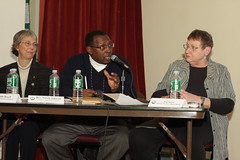The United States Constitutional Requirements of Due Process Applied to the Public Employment Relationship of School Personnel in Texas
Barbara A. Thompson, M.S.
PhD Student in Educational Leadership
College of Education
Prairie View A&M University
Administrative Assistant
College of Engineering Graduate Affairs and Research
William Allan Kritsonis, Ph.D.
Professor and Faculty Mentor
PhD Program in Educational Leadership
Prairie View A&M University
Member of the Texas A&M University System
Visiting Lecturer (2005)
Oxford Round Table
University of Oxford, Oxford England
Distinguished Alumnus (2004)
Central Washington University
College of Education and Professional
ABSTRACT
Most of the legal disputes arise out of the employment of public school personnel. Laws that affect the employment relationship, the constitutional concept of due process of law, different employment arrangements available to public schools in Texas, the hiring and firing process, and the legal issues that arise in these contexts are examined.
Introduction
The United States (U.S.) Constitution applies to the public employment relationship (Walsh, Kemerer & Maniotis, 2005). This fact distinguishes public employment from private employment. The due process of the Fourteenth Amendment is not invoked in the private sector and it is not a guarantee against incorrect or poor advisement. According to the U.S. Constitutional requirement of the due process clause, states must afford certain procedures before depriving individuals of certain interests. Laws and legal proceedings must be fair. When a person is treated unfairly by the government, including the courts, he is said to have been deprived of or denied due process. (The Lectric Law Library’s Lexicon on Due Process, n.d.). The focus is on deprivation of liberty or property. Certain procedures are considered due process and certain interests are life, liberty, or property. The Supreme Court requires individuals to show that the interest in question is either their life, their liberty, or their property. If the interests are not in either of these categories, life, liberty or property, no matter how important it is, it doesn’t qualify for constitutional protection. The U.S. Constitution only restricts governmental action.
Rights can be regulated or taken away altogether if due process of law is provided (Walsh, Kemerer & Maniotis, 2005). The due process clause serves to the use of fair procedures, more accurate results that would prevent the wrongful deprivation of interests. Due process provides individuals the opportunity to be heard from their point of view. This allows the individual to feel that the government has treated them fairly. The due process clause is essentially a guarantee of basic fairness by giving proper notice, providing an opportunity to be heard at a meaningful time in a meaningful way or a decision supported by substantial evidence. The more important the individual right in question is, the more process that must be afforded (Exploring Constitutional Conflicts, 2009).
The Purpose of the Article
The purpose of this article is to focus on the constitutional concept of due process of law, different employment arrangements available to public schools in Texas, the hiring and firing process and the legal issues that arise in these areas.
The Constitutional Concept of Due Process
In any personnel decision, the question is whether the employee was deprived of any property or liberty with the constitutional guarantee of due process of law. The 1972 U.S. Supreme Court case of Board of Regents v. Roth, ruled that teachers are protected under the 14th amendment property right of continued employment if the state law gives them a legitimate claim of entitlement to it (Walsh, Kemerer & Maniotis, 2005). Before any process is due, there must be state action and a significant, more sudden and dramatic deprivation of life, liberty or property. For example,
The federal court is not the appropriate forum in which to review the multitude of
personnel decisions that are made daily by public agencies. We must accept the harsh fact that numerous individual mistakes are inevitable in the day to day administration of our affairs. The United States Constitution cannot feasibly be construed to require federal judicial review for every such error. In the absence of any claim that the public employer was motivated by a desire to curtail or to penalize the exercise of an employee’s constitutionally protected rights we presume that official action was regular and, if erroneous, can best be corrected in other ways. The Due Process Clause of the Fourteenth Amendment is not a guarantee against incorrect or ill-advised personnel decisions. (Russell v. El Paso I.S.D., 1976, p. 565.)
When the government deprives an individual of life, liberty or property, the due process clause is invoked. A property right protected by the Fourteenth Amendment may not be taken away without providing a person with due process (Walsh, Kemerer & Maniotis, 2005). Governmental action is restricted by the U.S. Constitution. In the private section, the due process clause is not invoked. Due process is not an absolute. It varies according to the deprivation of property.
When a person accepts a position with a school district on an at-will basis, he or she has no property right in the job (Walsh, Kemerer & Maniotis, 2005). There is an at-will employee contract that incorporates an at-will relationship. If the at-will employee points to the employee’s policies and procedures manual as reasons not to be fired, no process is due. The at-will employee has a contact where the at-will relationship is stated and each party is free to end the employment relationship without notice, hearing or good cause (Walsh, Kemerer & Maniotis, 2005). There is no property right in the job, therefore no process is due. If the employee’s contract is not renewed and the contract has run its full course, there is no process due. If the contract is not renewed and there is another year on the contract, then due process is invoked. The employee who has a contract is entitled to due process.
Due process for a terminated employee includes giving timely notice of why the termination is occurring, a fair hearing so that the employee can defend himself, names and the nature of the testimony of witnesses against the employee must be available, and sufficient evidence to establish a good cause for dismissal must be presented (Walsh, Kemerer & Maniotis, 2005). The employee can be on the job for thirty years or the employee can be a one year probationary teacher. If the contract was terminated before the stated expiration date, the property right of the individual is in question and due process is invoked. Texas employees are allowed an independent hearing. Any decision to terminate a contract comes back to the school Board before it is final. The employee must produce clear evidence if they charge the Board with partiality.
The liberty right of the individual addressed in the Fourteenth Amendment suggests that the parent has a right to select a non-public school, the right to privacy and the right to a good reputation. In the 1972 Supreme Court case Wisconsin v. Constantineau (p.437), the employee stated the government put his name, honor and reputation at state, therefore a notice and an opportunity to be heard was essential. Stigmatizing statements create a right to a name clearing hearing only if they arise in conjunction with termination or non-renewal of employment as in the Siegert v. Gilley, 1991 court case. If the employee publicized the defamatory remarks, due process is not invoked. There is no right to a name clearing hearing. In Burris v. Willis I.S.D., 1983, a teacher claimed that when a board official read a letter about him at an open board meeting and in so doing, it violated his constitutional rights by depriving him of a liberty right to a good reputation. The teacher’s claim was rejected because the file was kept confidential.
Employment Arrangements, Contracts and Legal Recourse
There are six types of employees within the public school (Walsh, Kemerer & Maniotis, 2005). They are at-will employees, non-chapter 21 contract employees, probationary contract employees, term contract employees, continuing contract employees and third-party independent contract employees. Legal issues arise within each area when the relationship is ended.
At Will Contracts
The at-will employee has a contact where the at-will relationship is stated and each party is free to end the employment relationship without notice, hearing or good cause. This employee can be terminated for good reasons, bad reasons, or ‘no reason at all’. ‘No reason at all’ refers to a reason based on a bad reason that violates state or federal law. If the decision is a wrongful discharge and the employer violated state or federal law, the employee can sue (Walsh, Kemerer & Maniotis, 2005). The at-will relationship is the norm in the private sector. For example, an employee in at at-will relationship in the private sector can be described as an employee working for 30 years and quit his or her job tomorrow. Also, an employee can go into work the next day and be fired (Walsh, Kemerer & Maniotis, 2005). The terminated at-will employee can file suit alleging his discharge was due to retaliation for his exercise of his constitutional rights when he or she blew the whistle on wrongdoing. The terminated employee can also file discrimination based on race, sex, religion, age, national origin, or disability if it can be proven.
Chapter 21 and Non Chapter 21 Contracts
Teachers certified under chapter 21 of the Education code must have a contract. Chapter 21 employees include the classroom teacher, librarian, nurse or counselor, which means a probationary, term or continuing contract. Section 21:201 describes a teacher under term contract law as a supervisor, classroom teacher, counselor or other full-time professional who must be certified under Subchapter B or a nurse. Non-chapter 21 employees do not need a contract and do not require certification. They are not subject to an independent hearing system or statutory non-renewal process. Positions such as business manager, director of transportation, director of construction and facilities or director of maintenance do not require certification. If there is a written employment contract, and the employee alleges the district violated the contract and meant him monetary harm, the employee can appeal to the commissioner pursuant to TEC § 7.107.
Probationary Contracts
Probationary contracts are for those teachers who have never taught before or who have not been employed for two consecutive years subsequent to August 28, 1967. (TEC § 21.102. The probationary period can be as long as 3 years except for experienced educators with previous employment in public school for 5 of the 8 preceding years. The probationary teacher will serve under a 3 consecutive one-year probationary contracts. Probationary periods can be for a semester when the school year falls in the middle of the year. A probationary teacher can resign without penalty up to forty-five days before the first day of instruction. If school starts in mid-August, the teacher must resign before July 1 or suffer sanctions imposed by the State Board of Educator Certification. A probationary contract can be non-renewed by the board even if the superintendent recommended that it be renewed (Berry v. Kemp I.S.D.).
Term Contracts
After the probationary period, the teacher must receive either a continuing or a term contract (Walsh, Kemerer & Maniotis, 2005). The length of the contract and the process for renewal, nonrenewal, or termination determines which contract to offer. A classroom teacher, superintendent, principal, supervisor, counselor or other full-time professional employee who holds a certification or a nurse may be offered a term contract. A term contract has a beginning date and an end date and is any probationary Chapter 21 contract for a fixed term that can be as long as 5 school years. As the end date approaches, some action must be taken. The resignation date for a term employee is 45 days prior to the first day of instruction which is the same for probationary employees (Walsh, Kemerer & Maniotis, 2005). A term teacher contract can be renewed by the school, non-renewed or terminated. Termination refers to the action of the district to end the contract prior to its normal expiration date. The teacher is deprived of property interest and good cause, thus due process is required.
A non-renewal of contract refers to the school district letting the contract expire. The employee is permitted to fulfill the terms of the contract and no new contract is offered. If there is a multi-year contract, the district extends the contract each year or if the contract is not extended in the 2nd year, it is still valid for that year. The contract is non-renewed. A term contract teacher is entitled to a hearing prior to nonrenewal. Once the teacher receives notice, a hearing can be scheduled within 15 days with the board or an independent hearing system that is closed to the public, unless the teacher requests an open hearing. A term contract teacher can be suspended, but not beyond the school year, without pay for good cause as determined by the school board. The teacher is entitled to request an independent hearing or the district can suspend the teacher with pay and non-renew the contract at the end of its term. The district must give notice of a proposed non-renewal to the teacher 45 calendar days before the last day of instruction. If the 45 days are not adhered to, the contract is automatically renewed. Complaints of procedural irregularities in the appraisal process cannot be resurrected at the contract non-renewal process (Walsh, Kemerer & Maniotis, 2005).
When the superintendent contract is up for non-renewal, reasonable notice of the reason for the proposed non-renewal must be given before the 30th day of the last day of the contract term. In contrast, the teacher term contract does not require reasonable notice of the reason for the proposed non-renewal.
Continuing Contracts
A continuing contract is issued to a classroom teacher, superintendent, principal, supervisor, counselor or other full-time professional employee who was eligible for a continuing contract. The contract rolls over form one year to the next year without the necessity of board action. Non-renewal does not apply to continuing contracts. A former administrator, who moves into a teaching position and teaches children, can be issued a continuing contract. There is no specific length of time for continuing contract. The contract remains in effect until the teacher resigns, retires, is terminated, or is returned to probationary status. The continuing contract teacher can be terminated according to the independent hearing system, at any time for good cause (failure to meet the standards of conduct for the profession as generally recognized and applied in similarly situated school districts in the state) as determined by the board of trustees (TEC §21.156). Instead of discharge, a school can suspend a continuing teacher contract with notice, entitlement to an independent hearing, and without pay for a period of time not to exceed the current school year. The continuing teacher contract can return to a probationary status, provided the teacher consents to the move (Walsh, Kemerer & Maniotis, 2005).
Third-Party Independent Contracts
Full vested educators in the Texas Teacher Retirement system (TRS) could retire, begin drawing benefits, and them go to work at a salary equivalent to or better than what they had been making. School Boards could begin hiring teachers and not be burdened with having to treat them as employees. The teachers would keep their benefits under TRS (Att’y Gen. Op. GA-0018, 2003). If a school principal was dissatisfied with a teacher, he would call and ask for a different teacher. The school district did not employ the teacher and there was no contract and no legal requirements to end the relationship.
The Hiring and Firing Process
In 1992, the legislature created State Board for Educator Certification (SBEC), a 14 member board, as the key entity to oversee and regulate all aspects of the certification, continuing education, and standards of conduct of public school educators. SBEC has power to adopt rules for out of state educators, certification, requirements for renewal of certificates, and disciplinary procedures for suspension and revoking a certificate as well as approval and continuing accountability of such programs (Walsh, Kemerer & Maniotis, 2005). The board must annually review the accreditation status of each educator preparation program. An advisory committee has to be appointed by SBEC for each class of educator certificates. These rules must be submitted and reviewed by the State Board of Education and can be rejected by SBOE by a 2/3 vote. A public school district can hire certified and licensed employees. Certified employees are teachers, teacher interns, teacher trainees, librarians, educational aids, administrators, and counselors. Licensed employees are audiologists, occupational therapists, physical therapists, physicians, nurses, school psychologists, associate school psychologists, social workers, and speech pathologists (Walsh, Kemerer & Maniotis, 2005).
Texas public school districts are governed by the same laws that prohibit discrimination laws based on race, sex, religion, age, national origin, sexual harassment, and disabilities. Nondiscrimination laws apply to all employees regardless of the contract and have implications for the hiring process. Those involved in the hiring process need specific training (Walsh, Kemerer & Maniotis, 2005).
School districts are not required to advertise or post vacancies in their school. Advertising is a choice the school makes so that they can defend themselves against discrimination. The school board adopts policies regarding the employment and duties of personnel. The superintendent has sole authority to make recommendations to the board regarding the selection of all personnel and must be in the loop in hiring people. The principal does not hire staff, but must approve each teacher, reassignment, or staff appointment to the principal’s campus except for necessary teacher transfers due to enrollment shifts (11.202; Att’y Gen. Op. DM-27, 1991). In this regard, the superintendent has final placement authority for a teacher. SBEC must obtain criminal history on all certified educators. Background checks are not required by each school district except on contracted bus drivers of transportation services. If the bus driver has been convicted of a felony or misdemeanor involving moral turpitude, the bus drive may drive the bus only with the school’s permission. If an applicant lies on an application about the felony or misdemeanor involving moral turpitude, the applicant must be terminated (TEC 22.085). “Moral turpitude is a legal concept in the United States that refers to “conduct that is considered contrary to community standards of justice, honesty or good morals” (Moral turpitude, 2009). If an applicant has a clean record when hired, and is convicted of an offense while working for the district, a report must be made within seven calendar days by the superintendent or chief executive (19 TAC 249.14)
Concluding Remarks
In conclusion, school districts employ many people and must comply with many federal and state mandates. The relationship between employees in the public schools is determined by constitutional restrictions and statutory provisions in the Education Code and other legislation. Regardless of the type of contract used by a school district, contract with teachers must be in writing. Verbal commitments from school administrators may not be legally binding. Terms of the contract must be approved by the school board. According to Walsh, Kemerer & Maniotis (2008), the knowledge of the basics of the law should move from the central office to each campus. The director of personnel for the district should be an expert and have full of the United States constitutional requirements of due process applied to the public employment relationship of school personnel in Texas.
References
Att’y Gen Op DM-27, 1991
Berry v Kemp I.S.D., Dkt. No. 103-R10-600 Comm’r Educ. 2001): 158-159
Burris v Willis I.S.D., 713 F.2d 1087 (5th Cir. 1983): 131, 236
Linder, D. (2009). Exploring constitutional conflicts. Retrieved November 1, 2009 from
http://www.law.umkc.edu/faculty/projects/ftrials/conlaw/home.html
19 TAC 249.14
Russell v El Pas I.S.D., 539 F.2d 563 (5th Cir. 1976): 128
Siegert v Gilley, 500 U.S. 226 (1991): 131
TEC 21:201
TEC 7.107
TEC 21.102
TEC 11.202
TEC 22.085
The Letric Law (2009). Moral turpitude. Retrieved November 18, 2009 from
http://www.lectlaw.com/def/d080.htm
Walsh, J, Kemerer, F., & Maniotis, L. (2008). The educator’s guide to Texas school law.
6th ed. University of Texas Press: Austin, Texas.
Wisconsin v Constantineau, 400 U.S. 433 (1971): 130, 327
Dr. Kritsonis Recognized as Distinguished Alumnus In 2004, Dr. William Allan Kritsonis was recognized as the Central Washington University Alumni Association Distinguished Alumnus for the College of Education and Professional Studies. Dr. Kritsonis was nominated by alumni, former students, friends, faculty, and staff. Final selection was made by the Alumni Association Board of Directors. Recipients are CWU graduates of 20 years or more and are recognized for achievement in their professional field and have made a positive contribution to society. For the second consecutive year, U.S. News and World Report placed Central Washington University among the top elite public institutions in the west. CWU was 12th on the list in the 2006 On-Line Education of “America’s Best Colleges.”
Article from articlesbase.com








